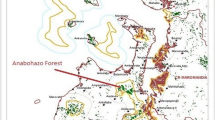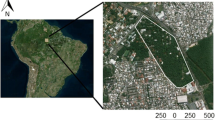Abstract
Vocal communication is an important modality for group-living primates inhabiting dense forest habitats that can hinder visual and olfactory signals. Nevertheless, research on primate vocalizations has historically focused on a narrow subset of haplorhine taxa; comparatively few studies have been focused on strepsirrhines, despite facing similar ecological and social challenges. Ruffed lemurs (Varecia)—a taxon known for their raucous calls—are rainforest specialists that exhibit strong fission–fusion dynamics and communally rear large litters of young. However, surprisingly few studies have examined Varecia vocalizations in the wild, meaning virtually nothing is known about the call types or how they facilitate their unique social and reproductive strategies. Our goal for this study was to examine how various contextual factors such as weather, behavioral state, and subgroup size and composition affected vocal activity across call types in wild black-and-white ruffed lemurs. We conducted focal follows on 31 individuals (two communities) in Mangevo (Ranomafana National Park) from May–August 2019 to record behavioral and vocal activity. We distinguished 11 call types, although three (hum, roar-shriek, chatter) constituted the majority of vocal activity. Calling rates were consistent throughout the day, but decreased with high rainfall. We found sex- and subgroup-specific differences in call usage, likely related to female dominance and subgroup composition, respectively. We identified behavioral contexts that some call types were consistently given in; this can be used to help infer call function. This study provides some of the first quantitative analyses of ruffed lemur vocal communication and lays the groundwork for more systematic hypothesis testing in future studies.




Similar content being viewed by others
Data availability
Data generated or analyzed during this study are available in the supplementary materials.
References
Arlet M, Jubin R, Masataka N, Lemasson A (2015) Grooming-at-a-distance by exchanging calls in non-human primates. Biol Let 11(10):20150711
Baden AL (2019) A description of nesting behaviors, including factors impacting nest site selection, in black-and-white ruffed lemurs (Varecia variegata). Ecol Evol 9(3):1010–1028
Baden AL, Wright PC, Louis EE, Bradley BJ (2013) Communal nesting, kinship, and maternal success in a social primate. Behav Ecol Sociobiol 67(12):1939–1950
Baden AL, Webster TH, Kamilar JM (2016) Resource seasonality and reproduction predict fission–fusion dynamics in black-and-white ruffed lemurs (Varecia variegata). Am J Primatol 78(2):256–279
Baden AL, Webster TH, Bradley BJ (2020) Genetic relatedness cannot explain social preferences in black-and-white ruffed lemurs, Varecia variegata. Anim Behav 164:73–82
Baker-Medard MSA, Baker MC, Logue DM (2013) Chorus song of the indri (Indri indri: Primate, Lemuridae): group differences and analysis of within-group vocal interactions. Int J Comp Psychol 26(4):241–255
Bergman TJ, Beehner JC, Painter MC, Gustison ML (2019) The speech-like properties of nonhuman primate vocalizations. Anim Behav 151:229–237
Bettridge CM, Kenworthy SP, Butynski TM, de Jong YA, de Kort SR (2019) Vocal repertoire and intraspecific variation within two loud calls of the small-eared greater galago (Otolemur garnettii) in Tanzania and Kenya. Folia Primatol 90(5):319–335
Bolt LM (2013) The function of howling in the ring-tailed lemur (Lemur catta). Int J Primatol 34(1):157–169
Bolt LM (2020) Affiliative contact calls during group travel: Chirp and wail vocalization use in the male ring-tailed lemur (Lemur catta). Folia Primatol 91(6):575–594
Braune P, Schmidt S, Zimmermann E (2005) Spacing and group coordination in a nocturnal primate, the golden brown mouse lemur (Microcebus ravelobensis): the role of olfactory and acoustic signals. Behav Ecol Sociobiol 58(6):587–596
Cheney DL, Seyfarth RM (2018) Flexible usage and social function in primate vocalizations. Proc Natl Acad Sci 115(9):1974–1979
Clink DJ, Ahmad AH, Klinck H (2020) Gibbons aren’t singing in the rain: presence and amount of rainfall influences ape calling behavior in Sabah, Malaysia. Sci Rep 10(1):1–13
Ey E, Fischer J (2009) The “acoustic adaptation hypothesis”—a review of the evidence from birds, anurans and mammals. Bioacoustics 19(1–2):21–48
Fishbein AR, Fritz JB, Idsardi WJ, Wilkinson GS (2020) What can animal communication teach us about human language? Philos Trans Royal Soc b: Biol Sci 375:20190042
Forrest TG (1994) From sender to receiver: propagation and environmental effects on acoustic signals. Am Zool 34(6):644–654
Gamba M, Giacoma C, Zaborra CA (2003) Monitoring the vocal behaviour of ruffed lemurs in the nest-box. Eaza News 43:28–29
Gamba M, Torti V, Estienne V, Randrianarison RM, Valente D, Rovara P, Giacoma C (2016) The indris have got rhythm! Timing and pitch variation of a primate song examined between sexes and age classes. Front Neurosci 10:249
Geissmann T, Mutschler T (2006) Diurnal distribution of loud calls in sympatric wild indris (Indri indri) and ruffed lemurs (Varecia variegata): implications for call functions. Primates 47(4):393–396
Giacoma C, Sorrentino V, Rabarivola C, Gamba M (2010) Sex differences in the song of Indri indri. Int J Primatol 31(4):539–551
Glander K (1993) Capture and marking techniques for arboreal primates. In: AR-LE Estrada, R Lopez-Wilchis, R Coates Estrada (eds) Estudios Primatalogicos En Mexico (pp 229–304). Universidad Veracruzana, Veracruz, Mexico.
Gustison ML, Johnson ET, Beehner JC, Bergman TJ (2019) The social functions of complex vocal sequences in wild geladas. Behav Ecol Sociobiol 73(1):14
Hafen T, Neveu H, Rumpler Y, Wilden I, Zimmermann E (1998) Acoustically dimorphic advertisement calls separate morphologically and genetically homogenous populations of the grey mouse lemur (Microcebus murinus). Folia Primatol 69(Suppl. 1):342–356
Hasiniaina AF, Scheumann M, Rina Evasoa M, Braud D, Rasoloharijaona S, Randrianambinina B, Zimmermann E (2018) High frequency/ultrasonic communication in a critically endangered nocturnal primate, Claire’s mouse lemur (Microcebus mamiratra). Am J Primatol 80(6):e22866
Holmes SM, Gordon AD, Louis EE, Johnson SE (2016) Fission-fusion dynamics in black-and-white ruffed lemurs may facilitate both feeding strategies and communal care of infants in a spatially and temporally variable environment. Behav Ecol Sociobiol 70(11):1949–1960
Kalan AK, Mundry R, Wagner OJ, Heinicke S, Boesch C, Kühl HS (2015) Towards the automated detection and occupancy estimation of primates using passive acoustic monitoring. Ecol Ind 54:217–226
Kulahci IG, Rubenstein DI, Ghazanfar AA (2015) Lemurs groom-at-a-distance through vocal networks. Anim Behav 110:179–186
Lemasson A, Pereira H, Levréro F (2018) Social basis of vocal interactions in western lowland gorillas (Gorilla g. gorilla). J Comp Psychol 132(2):141–151
Levréro F, Touitou S, Frédet J, Nairaud B, Guéry JP, Lemasson A (2019) Social bonding drives vocal exchanges in bonobos. Sci Rep 9(1):1–11
Macedonia JM (1990) What is communicated in the antipredator calls of lemurs: evidence from playback experiments with ring-tailed and ruffed lemurs. Ethology 86(3):177–190
Macedonia JM (1993) The vocal repertoire of the ringtailed lemur (Lemur catta). Folia Primatol 61(4):186–217
Macedonia JM, Taylor LL (1985) Subspecific divergence in a loud call of the ruffed lemur (Varecia variegata). Am J Primatol 9(4):295–304
Mitani JC, Stuht J (1998) The evolution of nonhuman primate loud calls: acoustic adaptation for long-distance transmission. Primates 39(2):171–182
Morland HS (1993) Reproductive activity of ruffed lemurs (Varecia variegata variegata) in a Madagascar rain forest. Am J Phys Anthropol 91(1):71–82
Morton ES (1977) On the occurrence and significance of motivation-structural rules in some bird and mammal sounds. Am Nat 111(981):855–869
Ordóñez-Gómez JD, Santillán-Doherty AM, Fischer J, Hammerschmidt K (2018) Acoustic variation of spider monkeys’ contact calls (whinnies) is related to distance between vocalizing individuals and immediate caller behavior. Am J Primatol 80(4):e22747
Overdorff DJ, Erhart EM, Mutschler T (2005) Does female dominance facilitate feeding priority in black-and-white ruffed lemurs (Varecia variegata) in southeastern Madagascar? Am J Primatol 66(1):7–22
Patel ER, Owren MJ (2012) Silky sifaka (Propithecus candidus) “zzuss” vocalizations: Sexual dimorphism, individuality, and function in the alarm call of a monomorphic lemur. J Acoust Soc Am 132(3):1799–1810
Pereira ME, Seeligson ML, Macedonia JM (1988) The behavioral repertoire of the black-and-white ruffed lemur, Varecia variegata variegata (Primates: Lemuridae). Folia Primatol 51(1):1–32
Pérez-Granados C, Schuchmann KL (2021) Passive acoustic monitoring of the diel and annual vocal behavior of the black-and-gold howler monkey. Am J Primatol 83(3):e23241
Petter JJ, Charles-Dominique P (1979) Vocal communication in prosimians. In: Doyle G, Martin R (eds) The study of prosimian behavior. Academic Press, Cambridge, MA, pp 247–305
Pflüger FJ, Fichtel C (2012) On the function of redfronted lemur’s close calls. Anim Cogn 15(5):823–831
Pozzi L, Disotell TR, Bearder SK, Karlsson J, Perkin A, Gamba M (2019) Species boundaries within morphologically cryptic galagos: evidence from acoustic and genetic data. Folia Primatol 90(5):279–299
Ramos-Fernández G (2005) Vocal communication in a fission-fusion society: do spider monkeys stay in touch with close associates? Int J Primatol 26(5):1077–1092
Rigamonti MM (1993) Home range and diet in red ruffed lemurs (Varecia variegata rubra) on the Masoala peninsula, Madagascar. In: Kappeler PM, Ganzhorn JU (eds) Lemur social systems and their ecological basis. Plenum Press, New York, pp 25–39
Ruch H, Zürcher Y, Burkart JM (2018) The function and mechanism of vocal accommodation in humans and other primates. Biol Rev 93(2):996–1013
Schamberg I, Cheney DL, Clay Z, Hohmann G, Seyfarth RM (2016) Call combinations, vocal exchanges and interparty movement in wild bonobos. Anim Behav 122:109–116
Schel AM, Zuberbühler K (2012) Dawn chorusing in guereza colobus monkeys. Behav Ecol Sociobiol 66(3):361–373
Schneider C, Hodges K, Fischer J, Hammerschmidt K (2008) Acoustic niches of Siberut primates. Int J Primatol 29(3):601–613
Spehar SN, Di Fiore A (2013) Loud calls as a mechanism of social coordination in a fission–fusion taxon, the white-bellied spider monkey (Ateles belzebuth). Behav Ecol Sociobiol 67(6):947–961
Sullivan R J (2017) Primate social structure as a predictor of modes of communication and the ability to learn a human language. In The Human Voyage (Vol 1, pp. 73–85). Australian National University, Acton, Australia
Teixidor P (1997) The function of ‘referential’ calls in two fission-fusion species: spider monkeys (Ateles geoffroyi) and chimpanzees (Pan troglodytes). Doctoral dissertation, University of St. Andrews, Scotland
Todt D, Goedeking P, Symmes D (eds) (2012) Primate vocal communication. Springer, Berlin
Trapletti A, Hornik K (2020) tseries: time series analysis and computational finance. R package version 0.10–48., https://CRAN.R-project.org/package=tseries
Turner ME, Harrenstien L (1985) Loud calls of the ruffed lemur, Varecia variegata. J Elisha Mitchell Sci Soc 101(1):1–8
Vasey N (2006) Impact of seasonality and reproduction on social structure, ranging patterns, and fission–fusion social organization in red ruffed lemurs. In: Gould L, Sauther ML (eds) Lemurs: ecology and adaptation. Springer, Boston, MA, pp 275–304
Vasey N (2007) The breeding system of wild red ruffed lemurs (Varecia rubra): a preliminary report. Primates 48(1):41–54
White FJ (1991) Social organization, feeding ecology, and reproductive strategy of ruffed lemurs, Varecia variegata. In: Ehara A, Kimura T, Takenaka O, Iwamoto M (eds) Primatology today. Elsevier, New York, pp 81–84
Wrangham R, Wilson M, Hauser M (2007) Chimpanzees (Pan troglodytes) modify grouping and vocal behaviour in response to location-specific risk. Behaviour 144(12):1621–1653
Acknowledgements
We thank our local guide, Ezafy, and cook, Tolotra, without whom this project could not have been completed. We thank the Centre ValBio staff for their extensive logistical support. Ford, Noro, and the Mangevo field teams were great campmates and helpful with troubleshooting. MICET provided vital documentation facilitation and Madagascar National Parks provided research permits (#109). The research herein adheres to the American Society of Primatologists’ Principles for the Ethical Treatment of Primates and was approved by Hunter College’s Institutional Animal Care & Use Committee (IACUC; protocol: AB-RuffedLemur-2.22). CB had a scientific research visa from the US-Malagasy Embassy. This study was generously funded by the CUNY Graduate Center Provost’s Office.
Author information
Authors and Affiliations
Contributions
CHB and ALB conceived and designed the study. CHB, MR, and FR carried out data collection. CHB conducted data analysis. ALB and CHB drafted the manuscript, and all authors approved it.
Corresponding author
Ethics declarations
Conflict of interest
The authors declare no conflict of interest. The research herein adheres to the American Society of Primatologists’ Principles for the Ethical Treatment of Primates and was approved by Hunter College’s Institutional Animal Care & Use Committee (IACUC; protocol: AB-RuffedLemur-2.22).
Additional information
Publisher's Note
Springer Nature remains neutral with regard to jurisdictional claims in published maps and institutional affiliations.
Supplementary Information
Below is the link to the electronic supplementary material.
About this article
Cite this article
Batist, C.H., Razafindraibe, M.N., Randriamanantena, F. et al. Factors affecting call usage in wild black-and-white ruffed lemurs (Varecia variegata) at Mangevo, Ranomafana National Park. Primates 63, 79–91 (2022). https://doi.org/10.1007/s10329-021-00956-0
Received:
Accepted:
Published:
Issue Date:
DOI: https://doi.org/10.1007/s10329-021-00956-0




